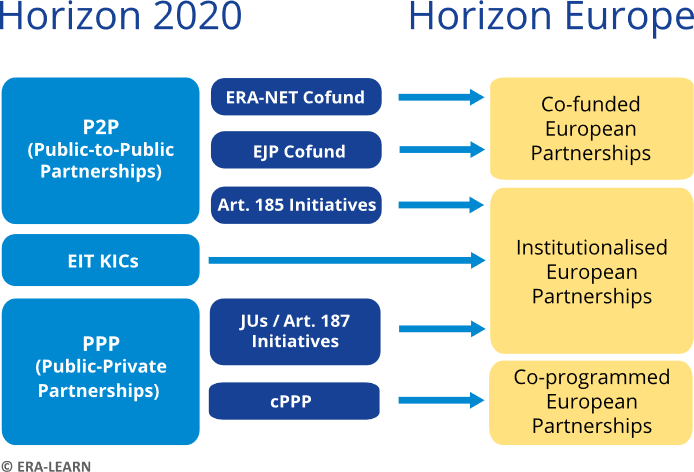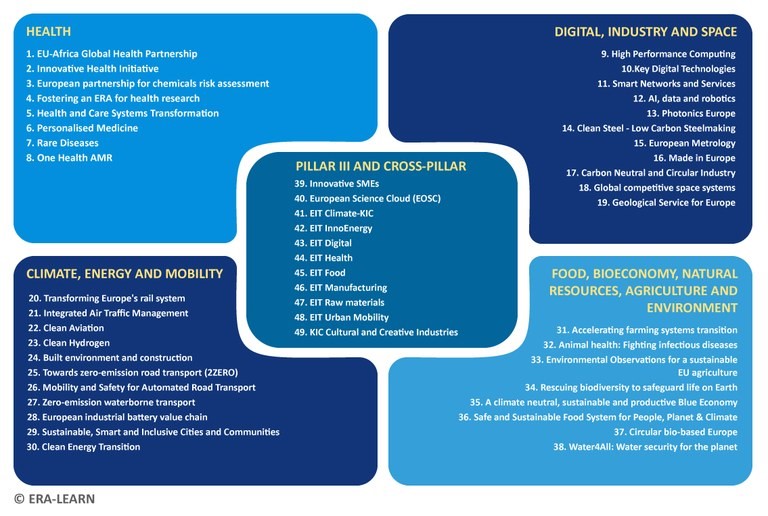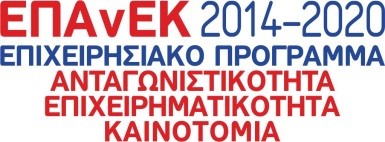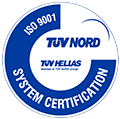1. Background – European Partnerships under Horizon 2020
Funding of European Partnerships under the EU Framework Programmes for Research was introduced in 2000, together with the adoption of the Lisbon Strategy and the decision to launch the European Research Area (ERA). Initially, partnerships were principally aimed at addressing fragmentation of the European Research and Innovation (R&I) landscape and avoiding overlaps through coordination of national efforts and actions. Later, mostly since 2008, new types of partnerships were launched and existing instruments were streamlined to serve broader purposes and address challenges including the economic crisis, promoting innovation and improving EU competitiveness, climate change, etc.
Horizon 2020, the previous EU framework programme for R&I supported two main types of partnerships
a)Public-Private Partnerships-PPPs
These are partnerships under which private-sector partners, the EU represented by the European Commission, and, possibly, other partners including public bodies, commit to jointly support development and implementation of a programme or activities in the field of research and innovation.
Public Private Partnerships are for the most part implemented through the following instruments: a) Joint Technology Initiatives (JTIs) / Joint Undertakings (JUs), b) contractual Public Private Partnerships (cPPPs)
b)Public-Public Partnerships- P2Ps
These partnerships are addressed to public-sector bodies or bodies fulfilling a public service mission at the local, regional, national or international levels which commit to jointly support development and implementation of a programme or activities in the field of research and innovation.
Partnerships between public-sector bodies are for the most part implemented through the following instruments: a) ERA-NET Cofund, b) European Joint Programme Cofund (EJP), c) Initiatives under Article 185 of the Treaty on the Functioning of the EU (TFEU)
In addition to the above, Horizon 2020 also supported the following types of partnerships:
- Knowledge and Innovation Communities-KICs) under the European Institute of Innovation and Technology (ΕΙΤ)
- Future and Emerging Technologies Flagships (FET Flagships)
- European Innovation Partnerships (EIPs)
- European Technology Platforms (ETPs)
Greek participation in Horizon 2020 partnerships was rather limited mainly due to public resource limitations. In the context of Public-to-Public Partnerships, Greece participates in European ERANETs with funding provided under the EPAnEK Operational Program. Greece is also a partner in the PRIMA Euromediterranean Initiative (Partnership for Research and Innovation in the Mediterranean Area), contributing €10 million, and in the European High-Performance Computing (Euro HPC) Joint Undertaking with €5 million from purely national resources.
2. European Partnerships under Horizon Europe
Horizon Europe has adopted a very different approach on European Partnerships in a clear effort to streamline the fragmented partnership landscape and reduce the types and number of partnerships.
Furthermore, many Member States have repeatedly pointed out both at Council and at European Research Area and Innovation Committee (ERAC) meetings that Partnerships should be launched only if they contribute to the integration of Horizon Europe objectives that cannot be implemented under Horizon Europe open calls.
Specifically, Horizon Europe comprises three types of partnerships:
- Co-programmed European Partnerships: they are based on Memoranda of Understanding (MoUs) concluded between the European Commission and private and/or public partners specifying the partnership’s objectives, the work programme, the commitments from both sides, expected outcomes etc., and are implemented independently by the partners and by Horizon Europe;
- Co-funded European Partnerships: based on grant agreements between the European Commission and consortiums of partners following a special call for proposals included in the Horizon Europe work programme;
- Institutionalized European Partnerships: long-term partnerships between several Member States based on the need for high integration and a joint governance structure. They are concluded on the basis of Articles 185/187 of TFEU and the European Institute of Innovation and Technology (EIT) legal acts.
The following diagram summarizes the differences between partnerships under Horizon 2020 and Horizon Europe:

European Partnerships under Horizon Europe:
- Represent an important investment (about 25% of the Horizon Europe budget and almost 50% of the Horizon Europe “Global Challenges and European Industrial Competitiveness” Pillar budget);
- Aim specifically at strengthening the economic and social impacts of research and innovation and improving the Union response to global challenges including climate change, digital transformation, public health protection, etc. through research and innovation initiatives.
In May 2019, the European Commission launched a consultation among Member States on a portfolio of 44 candidates for European Partnerships to be included in the Horizon Europe first strategic plan. After processing Member State (+ Island and Norway) replies, the EU published a report which includes a final portfolio of 49 candidates for partnerships adding with 4 more candidates for partnerships following proposals submitted by Member States.
The preliminary list of the 49 candidates for European Partnerships in Pillars II, III and cross-pillar is broken down as follows:
- Pillar ΙΙ: “Global Challenges and European Industrial Competitiveness” comprises 6 thematic clusters with 38 candidates for European Partnerships;
- Pillar ΙΙI: “Innovative Europe” comprises 9 candidates for partnerships;
- The European Open Science Cloud (EOSC) Partnership and the European Partnerships Innovative SMEs cross all thematic clusters.
The full list of the 49 candidates for European Partnerships is included in Orientations – towards the first Strategic Plan for Horizon Europe. Their breakdown by cluster and by Horizon Europe pillar is summarized below:

Frequently asked questions (FAQs) on European partnerships are available at:


















